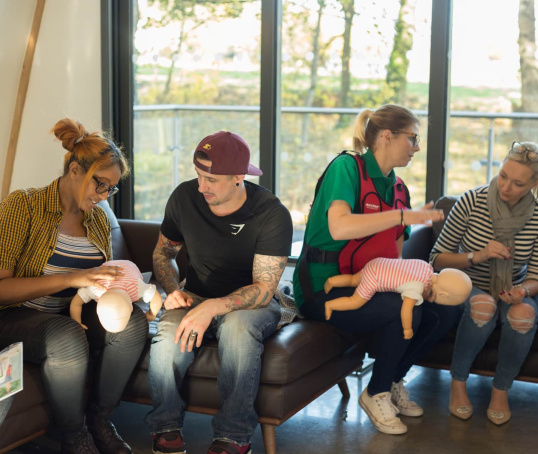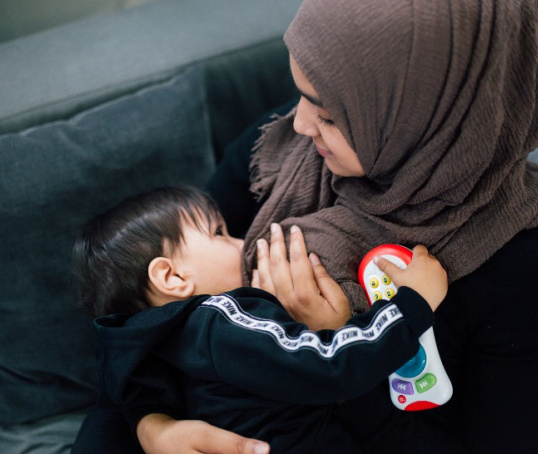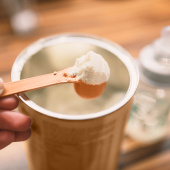Here we look at mixed feeding your baby, which is combining breastfeeding and bottle feeding
When it comes to feeding their baby, some parents decide to exclusively breastfeed and some to exclusively formula feed. Many families decide to combine breastfeeding and formula feeding; this often called combination feeding or mixed feeding (NHS, 2019).
What is mixed feeding?
Mixed feeding usually means mixing breast and bottle feeding. The content of the bottle can be either breastmilk or formula milk.
Watch our video to find out more about mixed/combination feeding.
Why do some families combination feed?
You might start mixed feeding for a variety of reasons.
- If you and your baby have some difficulties getting breastfeeding established or if there are concerns about your baby's weight, you might be advised to give some formula feeds alongside breastfeeding.
- You might need to leave your baby for periods of time (for example, if you are returning to work).
- Your partner might want to be involved with feeding.
- You might be bottle feeding and want to start or resume breastfeeding.
(NHS, 2019)
It can be helpful to talk to a breastfeeding counsellor, a midwife or health visitor about your options and the potential impact on breastfeeding of mixed feeding (see below). You could also call our infant feeding line on 0300 330 0700.
How do I combine bottle feeding and breastfeeding?
Some families choose to express milk and feed it to their babies through a bottle. They might do this if someone else would like to feed the baby or if the mum has to be away from their baby for a while.
Others choose to substitute some breastfeeds for formula. If you want to do this, you and your baby will adjust more easily if you reduce the number of feeds gradually (NHS, 2019).
You can offer formula feeds before, during, after or instead of a breastfeed. Talk to your midwife, health visitor or a breastfeeding counsellor about this, as different options will suit different circumstances. And will also depend on what you wish to achieve ultimately.
There are some cases when formula might be given before a breastfeed (for example, with babies who are not breastfeeding well). In other cases, the formula feed might be given instead of a breastfeed. This might happen if you’re not with your baby and can’t breastfeed or if someone else is sharing the feeding.
Gradually cutting down breastfeeding reduces the chance of your breasts becoming uncomfortably engorged. It will also reduce your risk of developing mastitis (NHS, 2019). It helps to reduce the number of breastfeeds slowly, starting with the one which is convenient for you (NHS, 2020). If you substitute a breastfeed with a formula feed, it may take around five to seven days for the amount of milk your breasts are producing to adjust to missing that one feed (NHS, 2017).
If you ‘top up’ with formula during one or more feeds, rather than replacing an entire feed, this is likely to extend the gap between breastfeeds. It will also signal to your breasts to make less milk (NHS, 2020).
On the other hand, if you've been advised to ‘top up’ as a temporary measure and want to return to exclusive breastfeeding, it is important to express milk between feeds to prevent a decrease in the amount of milk you make (NICE, 2017). Try and feed your baby any available breastmilk before each formula feed.
What effect will combining breastfeeding and formula feeding have?
Your baby will enjoy the benefits of breastmilk, even if you’re not exclusively breastfeeding. For instance, they will still gain some of the antibodies that will protect them against infection (NHS, 2019).
If you want to feed your baby with both breastmilk and formula milk, it is recommended to wait until feeding is firmly established before introducing a bottle (NHS, 2019). This can take up to a month (La Leche League, 2019).
It's best to wait until breastfeeding is established because breastmilk supply is generally driven by frequent, effective removal of milk from the breasts. Giving your baby formula reduces your milk supply, which is particularly important when you are both getting used to breastfeeding. If your baby breastfeeds less often, your breasts produce less milk (Daly and Hartmann, 1995).
You might have heard that babies can get ‘nipple confusion’ but there is no evidence that this exists (Kotowski et al, 2020).
How many breastfeeds does an older combination-fed baby need?
Older babies, beyond the newborn stage, can maintain your breastmilk supply alongside formula feeding as long as you breastfeed several times a day. Much older babies – from eight or nine months – can breastfeed just a handful of times a day, and there is still a supply.
Very well-established breastfeeding, with a baby who is one year or older, can continue with as few as one or two feeds in 24 hours.
If your baby is over six months they can use a beaker or cup rather than a bottle (NHS, 2020).
Tips to introduce a bottle to a breastfed baby
You might find your baby does not want to take a bottle at first. The different sensations may confuse them and they don’t know the bottle contains food. But there are lots of different things you can try to help your baby:
- Offer a bottle when your baby is relaxed and happy, rather than very hungry.
- Maybe ask someone else to offer a bottle so they can't smell their mother’s milk.
- Try softening the teat with warm, boiled water.
- Hold your baby in a different position from their usual breastfeeding one. It might help your baby get used to the new way of feeding.
- Try a different bottle or teat, this might make a difference.
- (La Leche League, 2019)
Unicef (2016) recommend feeding responsively, which means following your baby’s cues, whether breastfeeding or bottle feeding. They also recommend using paced bottle feeding. The way a baby is fed with the bottle can affect their comfort, their control of the amount of milk they drink, and the transition between breast and bottle (Kotowski et al, 2020).
Tips for paced bottle feeding
- Hold your baby upright, close to your body. (If your baby is lying back, they are less able to control how much milk they swallow, so they can overfeed.)
- Touch the teat against the baby’s top lip to encourage them to pull it into their mouth.
- Hold the bottle horizontal, so that when the baby is actively sucking, they get milk and when the baby is pausing, they don’t get milk.
- Give the baby several breaks by removing the bottle from their mouth.
- Watch what the baby is doing, rather than how much milk they have drunk. End the feed when the baby is no longer drinking.
- (UNICEF, 2016; La Leche League, 2019)
This all helps to build a close, loving relationship, a responsive feeding relationship, and avoids overfeeding your baby.
Where can I go for breastfeeding support?
If you have questions, concerns or need support, you can speak to one of our breastfeeding counsellors by calling our infant feeding line on 0300 330 0700, whether you are exclusively breastfeeding or using formula milk. Breastfeeding counsellors have had extensive training, will listen without judging or criticising and will offer relevant information and suggestions.
Further information
healthtalk.org has a comprehensive library of face-to-face interviews where parents share their experiences about breastfeeding, birth, parenting and many other issues.
Best Beginnings has video clips from the 'Bump to Breastfeeding' DVD.
UNICEF have produced a summary guide for parents on how to responsively bottle feed babies.
Daly SEJ, Hartmann PE. (1995) Infant demand and milk supply. Part 1: Infant demand and milk production in lactating women. J Human Lactation. 11(1):21-26. Available at: https://doi.org/10.1177/089033449501100119 [Accessed 3rd January 2022].
Kotowski J, Fowler C, Hourigan C, Orr F. (2020) Bottle-feeding an infant feeding modality: An integrative literature review. Maternal Child Nutrition. 16(2):e12939. Available at: https://doi.org/10.1111/mcn.12939 [Accessed 3rd January 2022].
La Leche League. (2019) Bottles and other tools. Available at: https://www.laleche.org.uk/bottles-and-other-tools/ [Accessed 3rd January 2022].
NHS. (2019) How to combine breast and bottle feeding. Available at: https://www.nhs.uk/conditions/pregnancy-and-baby/combining-breast-and-bottle/ [Accessed 3rd January 2022].
NHS. (2020) Pregnancy and baby guide. How to stop breastfeeding. Available at: https://www.nhs.uk/conditions/pregnancy-and-baby/stopping-breastfeeding/ [Accessed 3rd January 2022].
NICE. (2017) NICE Guideline NG75. Faltering growth: recognition and management of faltering growth in children. Available at: https://www.nice.org.uk/guidance/ng75 [Accessed 3rd January 2022].
UNICEF. (2016) Responsive feeding: Supporting close and loving relationships. Available at: https://www.unicef.org.uk/babyfriendly/baby-friendly-resources/relation… [Accessed 3rd January 2022].






